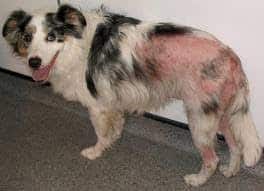Australian Shepherds can develop some pretty serious skin allergies. Is your aussie scratching all the time? Or licking all paws?Do you notice patches of hair missing, crusts or red pimples? If so, skin allergies might have something to do with it and It may be time to ask yourself “Does My Australian Shepherd Have Skin Allergies?”
This article will talk about the 3 most common types of allergies that affect Australian Shepherds. According to the area and climate where you live, you may see one kind being more frequent than the other.
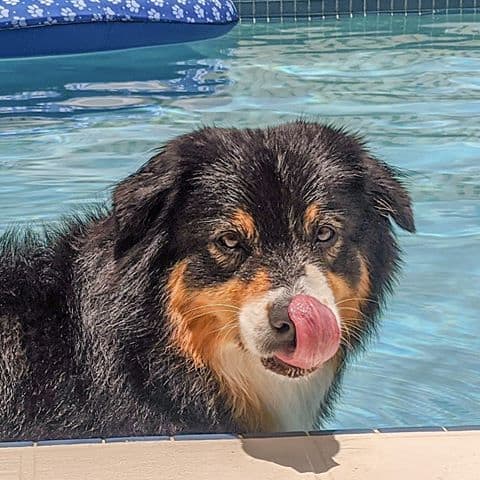
Flea Allergic Dermatitis
Yes, that little nasty bug’s saliva contains an allergenic substance that can cause a reaction in around 65% or more of dogs. Only one flea-bite can trigger a whole skin condition known as flea allergic dermatitis. This is by far the most common cause of allergy in dogs and it is actually pretty easy to treat and prevent.
One classic presentation of this disease is hair loss on a V-shape pattern along your Aussie’s back skin, starting right before the tail, also known as the “flea triangle”.
Once the defense of the skin has been broken by the allergic reaction, it becomes easy for bacteria and/or fungus to infect your puppy’s skin. That is what we call secondary infections. When we have a bacterial infection we usually see crusts and pustules (pimples) and it is usually very itchy. If we are dealing with fungus we usually have round areas of hair loss and it will not necessarily be itchy. A few skin tests, such as skin impression and fungal culture, will help differentiate between those infections and help your veterinarian choose the right treatment.
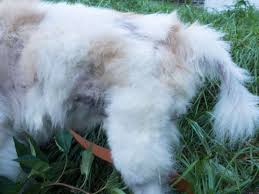
Let’s Talk About Australian Shepherd Skin Allergies and Fleas
Did you know that fleas live up to 120 days in your environment without any source of food?
Those little evil beings are very resistant! That is why it is very important to keep your Aussie always current on the flea prevention recommended by your veterinarian. If you miss a few days, all the eggs that were still in your environment will pop and the fleas will all be back in action.
To help with the environment control it is recommended to vacuum all areas of the house. Once you empty the vacuum container close the bag with a knot and throw away immediately because the fleas will come back from the bag to your house.
Always discuss with your veterinary before attempting to use chemicals to treat your environment, as many products can be toxic to pets.
Did you also know that the fleas do not live on the dogs, but in the environment?
You will only be able to see a flea on your Aussie if you have at least 100 fleas around. So that means that if you have 99 fleas in your house your Aussie is being bitten by them while you may not ever see one. We also carry fleas around on our shoes and clothing. Wildlife and cats that walk around carry them as well. So, even if your Aussie never leaves your home, the fleas will find him/her.
So, does your Aussie have fleas? If your puppy is not current on flea prevention the answer is YES, regardless if you see them or not.
The best way to control your environment is to keep your Aussie always current on flea prevention. If they cannot feed they will not stick around. Discuss with your veterinarian what flea prevention is best for your fur baby.
Australian Shepherd Skin Allergies Due To Atopic Dermatitis
Depending on the area you live this is also a very common type of allergy. Atopic dermatitis is the allergy to environmental agents such as grass or many types of plants, trees, dust, mites, pollen… basically, anything that is around.
Most dogs that have atopic dermatitis start by licking or chewing at their paws. That is because they are almost always allergic to grass. They can show hair loss (alopecia) and erythema (redness) around the paws and legs. Some other pets that are more allergic can show patches of hair loss all around the body. Once again, secondary infections can happen to make it all worse. This kind of allergy makes your puppy extremely itchy and you should be noticing your Aussie scratching all the time, even waking you up during the night.
Other dogs may not have any skin itchiness, but may often get ear infections. That could be another presentation of environmental allergies even if your Aussie does not scratch the body or licks the paws. With the ears sore or itchy, you will notice excessive shaking of the head or pawing at the ears. Also, you may see increased brown or yellow discharge when cleaning your Aussie’s ears.
Options of treatment to help manage atopic dermatitis
For a proper diagnosis, there is an allergy test (blood test), that will let you know for sure what is causing the symptoms and how bad your Aussie is reacting to each agent (such as dust mite, types of plants, pollen, storage mites). Once you find that out the laboratory recommends an injection that will help treat that allergy. That is called immunotherapy. The immunotherapy can be very effective but it takes a while until a good effect is seen.
Some new treatments such as Apoquel and Cytopoint have been showing excellent results as well. Some dogs will react all year round, but others may have only seasonal allergies. According to each case, the veterinarian will decide if your Aussie have to be consistently on medication, or if you should use them only when you notice the symptoms. The great thing about these medications is that they are very safe and side effects are extremely rare.
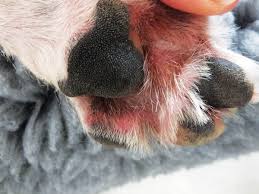
Australian Shepherd Skin Allergies From Food
The last of the 3 most common types of allergies is the food allergy.
Just like people, your Aussie can be allergic to basically anything. By experience, we notice that the most common dietary allergens are chicken and beef, but as previously mentioned, it could be anything.
Food allergy usually causes what we call generalized pruritus, which basically means itchiness all over the body. Most cases might not show any skin lesions, just the itchiness.
You might notice that your Aussie started scratching right after you switched their diet. It is also possible that your Aussie suddenly starts to react to the diet he/she has always eaten.
Australian Shepherd Food Trials
To diagnose food allergies, your veterinarian most likely will recommend a food trial. But what is that?
A food trial is trying out a diet on your Aussie that we know for sure will not cause any allergic reaction. There are some commercial prescription diets available that are specifically prepared for this. The protein in those diets (hypoallergenic diet) is processed into a very small particle that will not trigger any allergic reaction but still will be a complete balanced diet for your puppy.
The body is unable to identify this protein since it is too small to be recognized. Also, a veterinary prescribed novel (new) protein diet may be recommended.
Switching Foods For Your Aussie
It is important to know that it can take up to 2-3 weeks to completely clean the body from the previous diet. For the food trial to succeed it is necessary to feed exclusively the prescribed diet for 2-3 months (depending on the chosen diet). If after this period you notice marked improvement of the itchiness then we will know that your Aussie is definitely allergic to a component of the diet. Still, we will not know which one. From that point, you can either choose to keep your Aussie on the prescription diet for life or try to find what exactly is triggering the allergy.
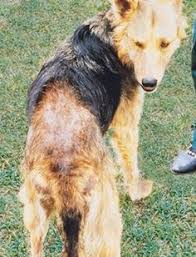
If you want to go ahead and know for sure what is triggering the itchiness you will need to expose your Aussie to each component, one at a time, until you see symptoms recurring. For example, once the allergy signs have completely resolved, you can try feeding your Aussie chicken for a week. If the chicken is the bad guy, you should see symptoms starting again very fast. But remember, your Aussie can be allergic to more than one component, so it is important to test them all.
Talk to your veterinarian if you think your Aussie has a food allergy. He can help you decide the best diet for the trial and also guide you through it.
It is important to manage our expectations because the proper diagnosis of skin diseases may not be so fast and direct. That happens because more than one type of allergy can happen at once. Also, there are other diseases of the skin that can be combined with the allergy, worsening the symptoms.
Australian Shepherd Skin Testing
You should be prepared for your veterinarian to recommend a few skin tests on your first visit to rule out some of those diseases. If your Aussie has a skin infection (pyoderma), a fungal infection (ringworm), or a mite infection (Demodex, Sarcoptes) it is important to treat it appropriately otherwise the allergy medications will not work.
The diagnosis of allergies is usually achieved by ruling out the most common causes. For example, your veterinarian will most likely recommend your Aussie to be current on flea prevention since flea allergy is the most common type of allergy. Once that is ruled out, then we will move forward to the next steps on diagnosis, possible allergy test to rule out atopic dermatitis or food trial to rule out food allergy.
Keep Your Aussie Comfortable
During this process, it is a priority to keep your Aussie comfortable. Communicate with your veterinarian if your Aussie is scratching a lot and he will recommend medications that will help control the pruritus (itching) until a definitive diagnosis is achieved.
Now that you have an idea of the most common causes of skin allergies, it is important to remember some key facts.
Key Factors of Australian Shepherd Skin Allergies
More than one type of allergy can happen together. So do not get frustrated if one treatment is not 100% effective. Your veterinarian will guide you through the process helping you find the right combination of treatment if needed.
Although sometimes required for more severe cases, steroids are not a safe long-term therapy for allergies. They can indeed resolve the itchiness fast but they can cause a wide range of serious side effects when used too often or on a long-term basis. Discuss with your veterinarian other options of treatment as there are much safer and effective medications on the market nowadays.
Over the counter
Over the counter, Benadryl will help control the itchiness slightly but will make your Aussie very sleepy. It is a good option to give your Aussie some comfort until you can make it to the vet visit, but will not work well long-term. Ask your veterinarian the right dosage according to your puppy’s weight.
When performing a food trial it is extremely important that you stick exclusively to the prescribed diet. Remember that your Aussie may be allergic to anything, so you might be feeding exactly what he is allergic to and you will think the diet is not working, when in fact, he has a food allergy. That could impact tremendously the outcome of the treatment.
Remember that fleas are always presented almost everywhere (either you see them or not) and most dogs are allergic to them. So keeping your Aussie current on flea prevention is a key fact for a successful treatment.
Australian Shepherd Skin Allergies Conclusion
The goal of this article is to give you a general idea of some common skin conditions that can affect your Aussie.
Always remember to visit your veterinarian for a proper diagnosis and treatment recommendation. Each case has to be evaluated on an individual basis as symptoms can vary widely and many conditions can happen at once. Your veterinarian will select the best approach for your individual case increasing the chances of successful therapy.
Any specific topic you want to know more about? Leave a comment and let us know!


